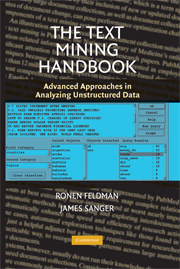Book contents
- Frontmatter
- Contents
- Preface
- I Introduction to Text Mining
- II Core Text Mining Operations
- III Text Mining Preprocessing Techniques
- IV Categorization
- V Clustering
- VI Information Extraction
- VII Probabilistic Models for Information Extraction
- VIII Preprocessing Applications Using Probabilistic and Hybrid Approaches
- IX Presentation-Layer Considerations for Browsing and Query Refinement
- X Visualization Approaches
- XI Link Analysis
- XII Text Mining Applications
- Appendix A DIAL: A Dedicated Information Extraction Language for Text Mining
- Bibliography
- Index
VI - Information Extraction
Published online by Cambridge University Press: 08 August 2009
- Frontmatter
- Contents
- Preface
- I Introduction to Text Mining
- II Core Text Mining Operations
- III Text Mining Preprocessing Techniques
- IV Categorization
- V Clustering
- VI Information Extraction
- VII Probabilistic Models for Information Extraction
- VIII Preprocessing Applications Using Probabilistic and Hybrid Approaches
- IX Presentation-Layer Considerations for Browsing and Query Refinement
- X Visualization Approaches
- XI Link Analysis
- XII Text Mining Applications
- Appendix A DIAL: A Dedicated Information Extraction Language for Text Mining
- Bibliography
- Index
Summary
INTRODUCTION TO INFORMATION EXTRACTION
A mature IE technology would allow rapid creation of extraction systems for new tasks whose performance would approach a human level. Nevertheless, even systems without near perfect recall and precision can be of real value. In such cases, the results of the IE system would need to be fed into an auditing environment to allow auditors to fix the system's precision (an easy task) and recall (much harder) errors. These types of systems would also be of value in cases in which the information is too vast for the users to be able to read all of it; hence, even a partially correct IE system would be preferable to the alternative of not obtaining any potentially relevant information. In general, IE systems are useful if the following conditions are met:
The information to be extracted is specified explicitly and no further inference is needed.
A small number of templates are sufficient to summarize the relevant parts of the document.
The needed information is expressed relatively locally in the text (check Bagga and Biermann 2000).
As a first step in tagging documents for text mining systems, each document is processed to find (i.e., extract) entities and relationships that are likely to be meaningful and content-bearing. The term relationships here denotes facts or events involving certain entities.
By way of example, a possible event might be a company's entering into a joint venture to develop a new drug.
Information
- Type
- Chapter
- Information
- The Text Mining HandbookAdvanced Approaches in Analyzing Unstructured Data, pp. 94 - 130Publisher: Cambridge University PressPrint publication year: 2006
Accessibility standard: Unknown
Why this information is here
This section outlines the accessibility features of this content - including support for screen readers, full keyboard navigation and high-contrast display options. This may not be relevant for you.Accessibility Information
- 6
- Cited by
